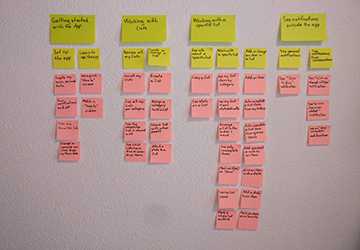Have you ever wished you could turn your creative passion into residual income? As an indie creator, starting a profitable podcast is an exciting path. From true crime to knitting tutorials, podcasting covers endless topics and taps into a vast audience. Over 100 million Americans listen to podcasts each month. With low startup costs and endless niche possibilities, there's massive potential to not only find listeners but also monetize your show. But simply releasing a few podcast episodes as a weekend hobby only goes so far. To build a sustainable, profit-pulling show, follow a strategic launch sequence. Think through your concept thoroughly, polish your episodes, and convert listeners into income. So, what steps set you up for podcasting success? Let's explore what's required to put together a show that not only builds an audience but ultimately charges for sponsorship spots and direct listener support.

Step 1: Pick A Compelling Niche + Target Audience
Establish your show's foundational focus before scripting potential episodes. Otherwise, you'll struggle from the first recording. What you talk about dictates who listens. So, define your niche to then resonate with your ideal target audience. For example, quick-hit news commentary, deep investigations into mysteries, and candid career advice appeal to different listener demographics.
So first ask yourself:
● What topics energize me enough to discuss them for hundreds of episodes?
● Am I aiming to inform, entertain, inspire, or help people?
● Who represents my dream podcast listener, and what do they care about?
Don't think about surface-level or follow fads here. Choose subject matter that reflects your authentic self to spark natural passion during recording sessions. Of course, pay attention to existing podcast popularity as well. For instance, true crime and comedy dominate charts, indicating strong listener demand. Just put your unique spin or take on an evergreen or buzzworthy genre. Once you land on your sweet spot topic, describe the core listener you want to serve. Be as specific as possible when envisioning their demographics and interests to inform content direction sharply.
Step 2: Set Up Your Gear + Recording Space
With your niche set, source key gear to achieve crisp sound in accordance with podcasting standards. The technical aspects intimidate some new media creators, but you truly need very little hardware to get going.
On the affordable end, essential equipment you likely already own does the trick:
● A decent USB microphone ($100-150 range)
● GarageBand or free editing software
● Over-ear headphones to gauge audio while recording.
● Pop filter for limiting vocal pops and distortion.
Optional extras include:
● A stand to precisely position your microphone.
● Portable recorder for interviews in the field
● Audio interface between mic & computer for enhanced sound control
Also, scout an ideal recording spot. Find a noise-free zone with soft surrounding surfaces. Blank wall corners significantly limit echo interference. Tip: Position the microphone close enough to pick up speech but not so near that the plosives cause distraction. With the right essential gear in place, built around a designated home studio area, you can eliminate major sound quality issues that hold back too many indie podcasters.

Step 3: Structure Your Show Format + Length
Before firing up the mic, script a loose outline molding the tone and segments inhabiting your podcast episodes. This bird's eye view of the format provides an advanced guide to smooth recording sessions.
Standard sections to incorporate per episode include:
● 30-60 second intro music plus brief show welcome
● One, two or a few attention-grabbing discussion topics
● Regular special features like guest Q&As or listener call-ins
● Clear wrap-ups summarizing key takeaways.
● Outros covering subscribe prompts, event promos, etc.
Regarding actual show length, moderately short instalments hook audiences while allowing you to publish frequently.
Try for:
● 15-45 minutes for shows releasing 2X or more per week.
● 45 minutes to an hour for weekly productions
The exact right run time depends on your niche and release aims. Just ensure you can sustainably recreate whatever format you choose according to an ongoing schedule. Map things out before formally scripting individual episodes. Treat this phase as floating general storyboarding, which will keep you on track when recording specific episodes later.
Step 4: Record A Backlog of Episodes
You have gear, and you know what you'll talk about. It's time to start recording episodes, right? Almost. Before premiering your podcast to the masses, build up an inventory of at least five fully complete shows.
Why prepare this backlog? Because:
● It allows testing and tweaking format based on objective early feedback (from yourself or a focus group) before publicizing.
● You have episodes ready to promote across platforms immediately instead of fumbling to produce content after the launch.
● If you need breaks or time for life stuff, banked inventory sustains release consistency.
● Removes pressure of starting from absolute scratch
Tip: Write show notes, including potential talking points before sessions. However, resist overly scripting dialogue itself to keep the conversation natural. Use these first recordings to discover your flow. Then, either iterate format where needed or simply stockpile inventory, giving you an optimal release buffer in the future.
Step 5: Distribute + Monetize Your Show
With a batch of episodes complete, polish up branding and supplementary assets like the cover art. Then submit your podcast across platforms such as:
● Apple Podcasts
● Spotify
● Google Podcasts
● Stitcher
● Additional niche hubs related to your topic.
Widespread distribution seats you in front of as many ears as possible from day one. Make it easy and obvious where fans can subscribe.
This foundation also lets you activate multiple income streams:
● Secure sponsorships from brands wanting exposure to your Audience.
● Enable voluntary tips from devoted supporters.
● Add affiliate links or product partnerships related to your niche.
● Build community hub listeners are willing to pay for
So, roll out the red carpet for listeners to access episodes and ultimately fund your indie podcasting career!
The Key Is Consistency
Launching a profitable indie podcast requires consistency over time. Stick to a reliable release cadence, engage with fans, and iterate based on feedback. Eventually, ad dollars, sponsors, and loyal listeners funding you month-to-month will grow. It won't happen overnight, but by taking the proper steps initially, you set yourself up for money-making success by podcasting about your passion. What niche would you explore if you started a podcast? Share your hypothetical show ideas below!





